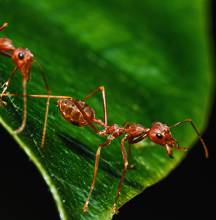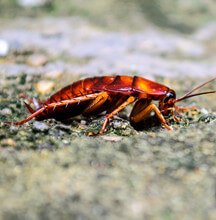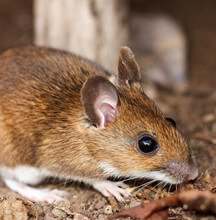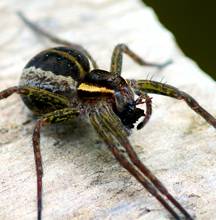Termite Information
Termites exist in 49 of the 50 United States. There are 3 basic types of termites including subterranean, drywood and dampwood. All types are considered social insects and live in colonies. Depending upon what geographic region you live in the "swarming season" runs from late spring into the fall. The damage caused by termites often goes completely undetected because they eat wood from the inside out.
The most common termites are subterranean species. From nests they build colonies - winged, mature adults are called alates. The alates go out and create their own nests during the springtime. The offspring, called alaeat leave the nest in swarms all at the same time. Observing winged termites inside your home is usually a key indicator that the wood in our house is acting as their food source. It's definitely time to fill out our "get a quote" form and receive help from our network of pest control experts. The presence of alates on your window sills or around doors is another obvious indicator. Identifying a termite versus a flying ant is a bit tricky. A termite has rear wings (2 sets) that are the same length as their front wings. Fly ants have shorter rear wings. Termites have wide waists - also the antenae on a termite is straight whereas on a flying ant the antennae have elbows and jointed bends.
Mud tubes are another item you may notice that indicate a potential termite problem. Look around your foundation, near pipes (especially that sweat), check crawl space, attic and any other open entry points around your house. A termite colony will build access tunnels. Here is what a mud tube or shelter tube looks like. Mud tubes are made up of wood, soil and other compound matter. These tubes act as pathways and protection for the colony along with providing much needed moisture. Since wood is the primary source of food being aware of proximity of much to your foundation, dead trees and firewood piles proximity to the house is important in protecting your home.
Another warning sign is the presence of "discarded wings". When a swarm of termites leaves their nest to begin a new colony they only fly one time. Upon landing they shed their wings. If you find wings be sure to try and compare the size to evaluate if they indeed are termites or the flying ant - see above the difference in length of wings.
One final observation is wood damage. If you find wood that appears eaten or in decay for no obvious reason it is time to get a professional inspection.
Treatment of Termites
Subterranean termite treatment has changed over the past 30 years. Today there are a number of customized methods that did not exist a decade ago. Additionally, many people choose to implement a pre-treatment plan rather than wait to see if the problem occurs.
Preventative Ideas:
Here is a list of things you can do to prevent infestation
- Fix all water and plumbing leaks.
- Keep mulch away from your foundation.
- Don't let trash sit out in the open.
- Keep yard or land free of fallen trees and branches.
- Stack firewood away from wooden structures and your home.
- Divert all water away from the foundation, check grading to ensure rain flows away from the house.
- Regularly clean out the gutters..
- Make sure no wood or organic materials have contact with ground moisture
Liquid Pesticide Applications
A special liquid is applied completely around and underneath a structure covering all areas where termites might gain access. This method creates a barrier point. For new construction, this is accomplished by treating the graded soil and foundation walls before the slab is poured. For an existing building, the perimeter of the foundation is trenched and drilled, then treated with termiticide. The treatment puts a chemical blanket between the termites in the soil and the structure. The chemical blanket can also affect those termites inside a building by preventing their successful return to the soil. Without an escape pathway these termites will die.
Repellent Termiticides
Repellent termiticides are fast acting nerve poisons that are highly toxic to termites, however, non toxic to people or pets.
The advantage of repellents is they keeps termites out of a structure. Pyrethroids used for these barriers are not very costly and last for years. The disadvantage is that termites are able to detect these termiticide barriers in the soil and avoid lethal contact with them.
Non-Repellent Termiticides
A non-repellent termiticide is a treatment method that termites cannot detect. Hence, the termites tunnel into the chemical barrier, make contact and die. A few manufacturers and compounds include:
Premise (Bayer Corporation, Kansas City, Mo.) contains the active ingredient imidocloprid.
Termidor (BASF Corporation, Research Triangle Park, N.C.) The active ingredient is fipronil.
Phantom (BASF Corporation, Research Triangle Park, N.C.) The active ingredient in Phantom is chlorfenapyr.
Liquid Termiticides
Pros
- Provides instant barrier and protection
- Lasts for years in soil
- Quality coverage capability
- Economical
Cons
- Doesn't always prevent all points of access effectively
- Disturbs sightlines on existing structures
- May impact water contamination
Subterranean Termite Bait Systems
Termite baits are designed to suppress or eliminate the termite colony living in the soil.
The first commercial termite baiting system became available over 20 years ago. Since then, several termite bating systems have been developed. Most termite bait systems function the same way. Installation involves plastic stations being inserted into the ground around about every 10 feet. Inside these stations are untreated monitors. The stations are then inspected every few months. If live termites are found in the station, a toxic bait will be placed inside the station. The idea is to get the termites that have been recruited to the wood monitor to now pick up the bait .
Because the in-ground bait stations are placed outside the structure, they do not directly affect termites that are already foraging inside. To address these inside infestations, certain manufacturers provide above-ground stations. Above-ground stations are basically plastic boxes that contain a paper matrix (bait) laced with the active ingredient (toxicant). The boxes can be attached over a termite mud tube or directly onto infested wood. The termites forage inside the box and consume the paper bait. The brand name bait systems are:
Sentricon System – It is now the most widely used bait system within the United States. Developed Dow AgroSciences group and the University of Florida as a stand-alone bating system. This system can be used in conjunction with non-repellent termiticides.
The bait system consists of in-ground stations that contain 2 pieces of untreated wood (“monitors”). The stations are checked at first monthly and then on a quarterly schedule to see if termites have invaded or “hit” the monitors. If so, the termites are collected from the monitors and placed inside a tube of bait. The bait then replaces the monitors in the station and the termites must then eat their way out of the bait tube.
The Sentricon System is marketed as a termite colony elimination system. In order for a colony elimination system to work, the bait must affect almost every termite in the colony. Worker termites do all of the foraging, so how does the bait get from the worker termites to the rest of the colony? Remember that the worker termites are responsible for feeding all of their nest mates. They do this by consuming food themselves then regurgitating part of it into the mouths of the other colony members. This same natural behavior is exploited by the Sentricon system to disperse the bait toxicant throughout the termite nest. It is important to note that the bait cannot work too fast. If the active ingredient killed the termites too rapidly, the worker termites would die before they could pass the bait to other colony members.
The active ingredient in the Sentricon bait is noviflumuron, a slow acting toxicant. Noviflumuron is an insect growth regulator (IGR). IGRs interfere with the insect’s physical development. This particular IGR interferes with the insect’s ability to molt. Insects have their skeleton on the outside of their bodies, an exoskeleton. In order to grow larger they must periodically shed this exoskeleton in a process called molting. Noviflumuron does not allow the termite to molt properly, so it dies in the process. When noviflumuron is passed from one termite to another, the affected termites die during their next molt. In time, there are too few termites left to take care of the colony and feed the queen. When the queen dies the colony is eliminated.
Inserting the noviflumuron bait tube into the station.
The Sentricon system also supplies above ground stations that the pest management professional (PMP) can place directly on termite mud tubes or infested wood. Noviflumuron is the active ingredient in the above ground stations as well.
Exterra System – Developed by Ensystex and can be used either as a stand-alone bait or in combination with any liquid termiticide. The Exterra bait station is lined with strips of untreated wood, called “interceptors”. The center of the station is left empty until termites hit the station. When the station is hit, bait is placed in the center of the station but the interceptors are left in place so that termite feeding is not disturbed.
The active ingredient in the Exterra bait is diflubenzuron (dimilin). Like noviflumuron, diflubenzuron is a slow acting insect growth regulator that is passed from termite to termite by trophallaxis. Diflubenzuron also interferes with termite development by killing them during the molting process. Thus, like Sentricon, Exterra is a colony elimination system. As of this writing, Ensystex does not offer above ground bait stations.
FirstLine System – The FirstLine bait system was developed for use in combination with spot treatments of liquid termiticide.
The active ingredient in the FirstLine system is sulfluramid. Sulfluramid is a stomach toxicant that interferes with the termite’s ability to produce energy. Sulfluramid is faster acting than either noviflumuron or diflubenzuron. However, in the FirstLine system the concentration of sulfluramid is so low that exposed termites survive for approximately 3 weeks. This allows them enough time to pass the toxicant to other members of the colony. The FirstLine is a colony suppression system only. Therefore, remediation of an active infestation comes from the combined treatment of baiting and applying liquid termiticide at the site of infestation.
Subterfuge – This termite bait product is manufactured by BASF Corp.
The active ingredient, hydramethylnon, a slow acting stomach toxicant. The delayed activity of hydramethylnon allows the bait to be passed from termite to termite before the onset of any lethal effects.
Advance Termite Bait System – The active ingredient in the Advance system is diflubenzuron (the same active ingredient as the Exterra system described above). Installation intervals are for in-ground stations is every 10 feet around the perimeter of the structure with additional stations placed in locations with conditions conducive to termites. Inspections occur at 30 days after installation and quarterly thereafter unless one of the stations has had a termite “hit.” “Hit” stations are inspected every month.
Spectracide Terminate – Terminate is a consumer termite bait product that is available at hardware and home stores. It is manufactured by United Industries Corp. and is a stand-alone system. Monitoring is not part of the Terminate baiting process. The active bait is inside of the stations.
Professional Termite Baiting Systems
Pros
- Baits are very environmentally friendly
- Termite baits are ideal for use around structures inhabited by persons with concern about chemical use on their property
- Effective treatment method of areas with lakes, ponds and water table concerns
- Simple installation
Cons
- Slow to monitor existence of any infestations
- Ongoing maintenance cost to monitor system
- Not effective for the elimination of existing colonies





